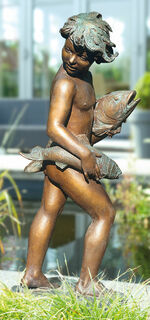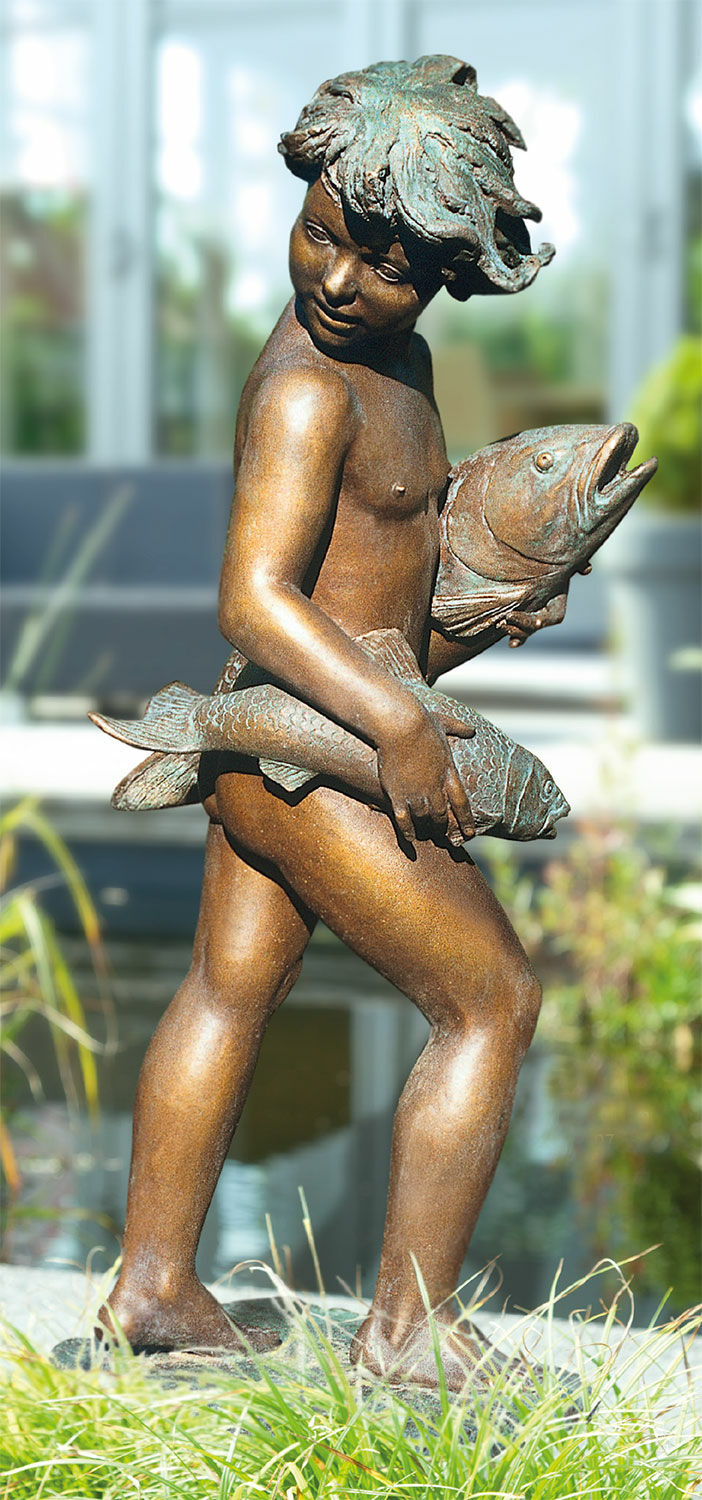Garden sculpture "Fish Thief", bronze
Garden sculpture "Fish Thief", bronze
Quick info
limited, 12 copies | numbered | signed | bronze | hand chased and patinated | size 97 x 43 x 28 cm (h/w/d) | weight approx. 41 kg | incl. mounting hardware
Detailed description
Garden sculpture "Fish Thief", bronze
Sculpture in bronze, cast using the Lost-Wax-Process, chiselled and patinated by hand. Limited to 12 numbered and signed copies. Size 97 x 43 x 28 cm (h/w/d). Weight approx. 41 kg. Can be fastened using the threaded pin supplied.
About Erwin A. Schinzel
German sculptor, 1919-2018
Erwin A. Schinzel was a true "classic" artist among sculptors. An artist who created works that are entirely in the tradition of their art. They openly and undisguisedly inherit the greats of their field and yet still appear up to date.
His works show the sovereignty of craftsmanship of a time when accuracy and perfection of representation were still the highest standards of sculpture. They deliberately ignore all the fashions and modernisms of the century that essentially encompassed his lifetime.
Schinzel was noticed early on for his creative genius: Just twenty years old, he attended the Academy of Fine Arts in Berlin and was accepted into the small, exclusive circle of Arno Breker's master students. He took trips to Greece and Crete, where he studied the ancient examples of sculpture.
He was a freelance artist for eight decades and created hundreds of sculptures during this period. Furthermore, he worked as a professor at the International Academy of Fine and Applied Arts in Altenburg and the International Academy in Bologna.
His sculptures mainly have one theme: the human being in all its undisguised beauty. With these sculptures, beauty appears unbroken. And it is, in a sense, the eye of the beholder that is celebrated here.
"The human being who, with creative talent, gives the experience of his environment back to us so that people can find themselves delighted in it, can only and need to see with the eyes of the soul in order to speak with his hands a language that is timeless and knows no boundaries." (Erwin A. Schinzel)
His oeuvre, which comprises many hundreds of works, also includes numerous depictions of animals, which in their vividness of execution can rival the works of the greatest animalists at any time.
Works from Schinzel's studio in Waldbronn, Germany, where he pursued his creative work daily, can be found in numerous collections at home and abroad. The artist passed away in December 2018.
An alloy of copper with other metals (especially with tin) used since ancient times.
When casting bronze, the artist usually applies the lost-wax technique which is dating back more than 5000 years. It's the best, but also the most complex method of producing sculptures.
First, the artist forms a model of his sculpture. It is embedded in a liquid silicone rubber mass. Once the material has solidified, the model is cut out. The liquid wax is poured into the negative mould. After cooling down, the wax cast is removed from the mould, provided with sprues and dipped into ceramic mass. The ceramic mass is hardened in a kiln, whereby the wax flows out (lost mould).
Now we finally have the negative form, into which the 1400° C hot molten bronze is poured. After the bronze had cooled down, the ceramic shell is broken off and the sculpture is revealed.
Now the sprues are removed, the surfaces are polished, patinated and numbered by the artist himself or, to his specifications, by a specialist. Thus, each casting becomes an original work.
For lower-quality bronze castings, the sand casting method is often used which, however, does not achieve the results of a more complex lost-wax technique in terms of surface characteristics and quality.
Term for an art object (sculpture, installation), which is produced in multiple copies in a limited and numbered edition according to the artist‘s will.
Artist's multiples have been called the most accessible and affordable art on the market.
A plastic work of sculptural art made of wood, stone, ivory, bronze or other metals.
While sculptures from wood, ivory or stone are made directly from the block of material, in bronze casting a working model is prepared at first. Usually, it is made of clay or other easily mouldable materials.
The prime time of sculpture after the Greek and Roman antiquity was the Renaissance. Impressionism gave a new impulse to the sculptural arts. Contemporary artists such as Jorg Immendorf, Andora, and Markus Lupertz also enriched sculptures with outstanding works.


